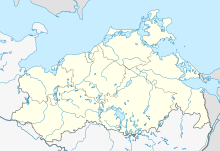Lower Recknitztal nature reserve
Coordinates: 54 ° 12 ′ 0.5 ″ N , 12 ° 33 ′ 31.8 ″ E
The nature reserve Unteres Recknitztal is a nature reserve in Mecklenburg-Western Pomerania east of the town of Marlow . It covers 1,470 hectares and is intended to protect the section of a river valley moor and the adjacent valley slopes. The designation took place in 1984 with two extensions in 1990 and 1994. The lower reaches of the Tribohmer Bach , which flows into the Recknitz near Gruel, belongs to the Lower Recknitz Valley nature reserve.
The condition of the NSG is only satisfactory, as the peatland areas continue to be drained despite the abandonment of use. Species-rich wet meadows are subject to succession with woody growth. The area can be crossed on hiking trails.
history
Due to their wetness and impassability, the areas were not used until late. On the Swedish matriculation card , only the narrow floodplain areas at the edge are used as meadows. Planned drainage measures began around 1750, which led to the use of meadows and pastures. Furthermore, the economically important peat was extracted for heating purposes. Extensive interventions were carried out as part of the complex amelioration in GDR times with upheaval, new sowing and mineral fertilization. Despite everything, the area is one of the few larger fen areas in the state that have not been completely converted into seed grassland. The Recknitz was straightened in the upper area of the nature reserve. Many oxbow lakes of the river have been preserved.
Flora and fauna
Due to the extensive protected area, the flora and fauna are diverse. In the oxbow lakes and open peat cuttings there are aquatic plants such as B. Crab claw , water feather , common water hose and frog bite . The banks are lined with reed beds , large sedge beds and alder-gray willow bushes . The original vegetation of the bog , which consisted of large and small sedge beds with a high proportion of brown moss, is only rudimentary. In their place today there are reed grass meadows and knotweed-cabbage thistle meadows. Botanical specialties are orchids as well as fever clover , ball bulrush and small valerian .
Beech forests grow on the slopes of the valley edge areas, some of which are part of the nature reserve . Numerous species of fish have been found in the waters. In the oxbow lakes z. B. gudgeon , pike , loach , bleak and perch . Furthermore, there are numerous types of dragonflies, such as banded demoiselle , moon azure damsel , two-spot , little pitch dragonfly , willow damsel . Numerous species of mollusks live in the river . The area is home to around 100 species of breeding birds, including the lesser spotted eagle , common snipe , bittern , corncrake and bluethroat . Among the mammals, the occurrence of otters and beavers should be emphasized.
literature
- Environment Ministry Mecklenburg-Western Pomerania (Ed.): Unteres Recknitztal 210 in: The nature reserves in Mecklenburg-Western Pomerania . Demmler-Verlag, Schwerin 2003, p. 226 f.




